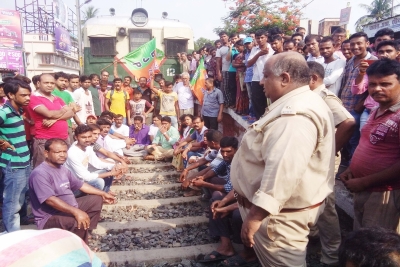By Milinda Ghosh Roy
Kolkata, June 10 (IANS) West Bengal is virtually on the boil, thanks to a bloody tussle between the ruling Trinamool Congress (TMC) and the resurgent BJP over the political turf, clearly in view of the next Assembly elections slated two years from now.
Over the past few months, the state has witnessed umpteen incidents of political violence and killings as the Bharatiya Janata Party (BJP) has been making desperate attempts to expand its base while the Trinamool led by Mamata Banerjee has been resolutely resisting it.
Approximately 12 people from both the parties have lost their lives in political violence in West Bengal since the Lok Sabha polls commenced on April 11.
The developments have reached such a pass that Governor Keshari Nath Tripathi on Monday reached New Delhi and apprised Prime Minister Narendra Modi and Home Minister Amit Shah about the situation in West Bengal.
The Governor’s meetings with the Prime Minister and the Home Minister came amidst talks in the BJP, which is ruling at the Centre, about the scope for imposing President’s Rule in the state.
Only on Sunday, the Union Ministry of Home Affairs (MHA) voiced its deep concern over the situation in West Bengal and asked the state government to ensure normalcy.
The political violence involving the Trinamool and the BJP started in the run up to the just-held Lok Sabha elections and even marred the seven-phase polling in the state, to an extent that the Election Commission had to take an unprecedented step of curtailing campaigning by one day for the last phase of polling held on May 19.
However, after the BJP put up a stunning show by winning 18 Lok Sabha seats, up from 2 seats last time, in the state where 42 seats were at stake and ate into the Trinamool’s bastion, the violence has witnessed an upswing.
Both the Trinamool and the BJP are blaming each other for the violence.
Trinamool Secretary General Partha Chatterjee accused the saffron party of trying to use the Home Ministry for hatching political conspiracy and destabilising the Mamata Banerjee-led government.
“In Uttar Pradesh and Gujarat, children and Yadavs were getting killed. Where were you (BJP) then? BJP is creating disturbances and killing our workers. BJP is using Home Ministry for political conspiracy… to destabilise the elected state government,” he alleged.
The BJP, on the other hand, has charged Trinamool with fomenting violence to retain power.
“They are trying to hold on to power by resorting to the politics of violence. They are committing a big mistake. People have already given their verdict against such politics,” state BJP chief Dilip Ghosh said.
According to political analyst Maidul Islam, the stakes are high in Bengal politics as a lot of people are directly dependent on it for their livelihood.
“The unemployment rate in Bengal is very high. Many youth do not have productive work. So a large section of them depend on the economic spoils of the political parties and leaders to earn their livelihood,” he told IANS.
“These people’s lives get directly affected by the victory or defeat of the political outfit they are affiliated to. That’s why the stakes are so high here,” Islam added.
The blood spill, however, is not alien to Bengal politics. It has historical roots, which is different from the religion or caste-based crimes of north India.
Previously, political violence in the state was witnessed nearly a decade back when the Trinamool was trying to wrest power from the Left parties, which ruled it for 34 years.
The Nandigram and Singur agitations against the Left Front government provided immense political gains to the Trinamool which finally dislodged the Communist government in 2011.
The Election Commission’s reports on past Lok Sabha elections and annual reports of the National Crime Records Bureau (NCRB) show that violence goes hand-in-hand with elections.
According to the NCRB data, the state has topped the chart of political killings for many decades.
For 18 years, between 1999 and 2016, 20 political murders took place in the state each year on an average.
During the 2014 Lok Sabha polls, a total of 16 political workers were killed across India in poll-related violence, of which seven deaths took place in Bengal.
“Political loyalties are as important to the West Bengal youth as social identity. This is evident in the field of student politics, which is not immune to clashes among the impassioned youth either,” Islam said.
Just before the last phase of 2019 polls, BJP president Amit Shah’s rally in Kolkata was marred by violence as clashes broke out between Trinamool and BJP workers.
The vandalism of a bust of Bengal icon Ishwar Chandra Vidyasagar, a leading figure of the 19th century Renaissance, further worsened the situation by hurting cultural sentiments of the Bengalis.
Earlier, on February 10, sitting Trinamool MLA from Nadia district’s Krishnaganj, Satyajit Biswas, was shot dead from point-blank range. The ruling party held the BJP responsible for the murder.
On March 28, a BJP leader’s brother was hacked to death in Malda district.
The worst case of violence happened on Saturday in North 24 Parganas district’s Sandeshkhali, where at least three workers — two from the BJP and another from the Trinamool — were killed in a day, according to the police.
The political rivals, however, claimed the toll was higher.
–IANS
mgr/ssp/akk

